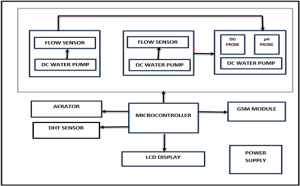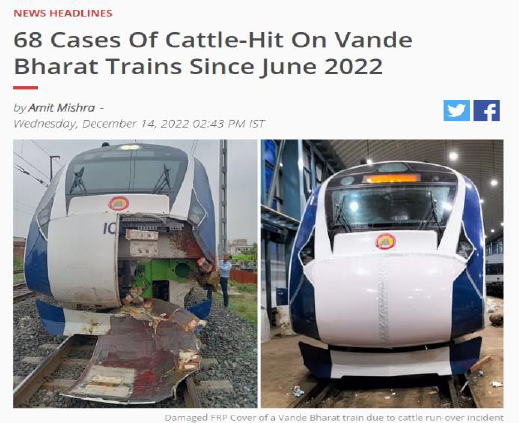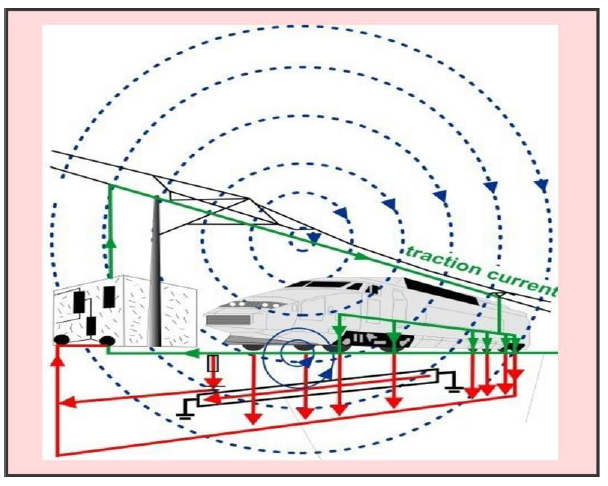Recent News
- Faculty and Students Leads to Patent Publication for Intelligent Shelf Management System July 22, 2024
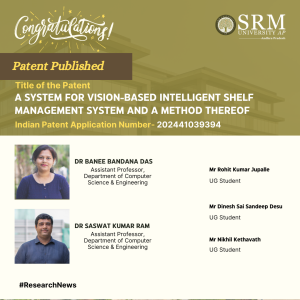 In a groundbreaking collaboration, Dr Banee Bandana Das, Assistant Professor in the Department of Computer Science and Engineering, and Dr Saswat Kumar Ram, Assistant Professor in the Department of Electronics and Communication Engineering, have joined forces with Btech-CSE students Mr Rohit Kumar Jupalle, Mr Dinesh Sai Sandeep Desu, and Mr Nikhil Kethavath to develop and patent an innovative invention.,” The team’s invention, titled “A SYSTEM FOR VISION-BASED INTELLIGENT SHELF MANAGEMENT SYSTEM AND A METHOD THEREOF,” has been officially filed and published with Application Number 202441039394 in the Patent Office Journal. This invention showcases the academic excellence and collaborative spirit within the institution, as faculty members and students work together to push the boundaries of technology and create solutions with real-world impact.
In a groundbreaking collaboration, Dr Banee Bandana Das, Assistant Professor in the Department of Computer Science and Engineering, and Dr Saswat Kumar Ram, Assistant Professor in the Department of Electronics and Communication Engineering, have joined forces with Btech-CSE students Mr Rohit Kumar Jupalle, Mr Dinesh Sai Sandeep Desu, and Mr Nikhil Kethavath to develop and patent an innovative invention.,” The team’s invention, titled “A SYSTEM FOR VISION-BASED INTELLIGENT SHELF MANAGEMENT SYSTEM AND A METHOD THEREOF,” has been officially filed and published with Application Number 202441039394 in the Patent Office Journal. This invention showcases the academic excellence and collaborative spirit within the institution, as faculty members and students work together to push the boundaries of technology and create solutions with real-world impact.
This significant achievement not only highlights the creativity and dedication of the individuals involved but also underscores the institution’s commitment to fostering a culture of innovation and research. The publication of this invention paves the way for further exploration and development in the field of intelligent shelf management systems, demonstrating the potential for transformative contributions to the industry.Abstract
This research offers the best solution to improve the business in the retail realm, maintaining On- Shelf Availability (OSA) is vital for customer satisfaction and profitability. Traditional OSA methods face accuracy challenges, prompting a shift to deep learning models like YOLO and CNN. However, data quality remains a hurdle. This research introduces OSA, a novel semi-supervised approach merging ’semi-supervised learning’ and ’on-shelf availability’ with YOLO. It reduces human effort and computation time, focusing on efficient empty-shelf detection. Implementing a Vision-Based Intelligent Shelf Management System empowers retailers with real-time insights, revolutionizing decision-making. The model is optimized for diverse devices and provides practical solutions for efficient retail operations. Balancing model complexity, size, latency, and accuracy, the research paves the way for an advanced, data-driven shelf management approach, contributing to improved shopping experiences and business profitabilityPractical Implementation and the Social Implications Associated
1. The present invention is a time-saving method in maintaining the stocks.
2. The use Vision-Based Intelligent Shelf-Management System provide a well alternative in reducing the labor efforts.
3. The system will help in terms of self-management system using machine learning techniques to optimize restocking decisions.
The present invention can be used in shopping malls and business areas for enhancing customer experiences and business and few application areas are:
• Smart City and smart Village
This technique and system can reduce the human efforts in identifying vacant slots for items in business areas and provides necessary inputs to fill the same within a time frame.
• Automobile Industry
The system can be easily integrated with the showrooms to identify the empty spaces and inform to get it fill with products.Collaborations
SRM AP Faculties and UROP StudentsFuture research plan
In the future, different deep learning and machine learning methods can be merged to explore better performance in identifying overlapping objects.
Continue reading → - Revolutionising Cattle Safety July 22, 2024
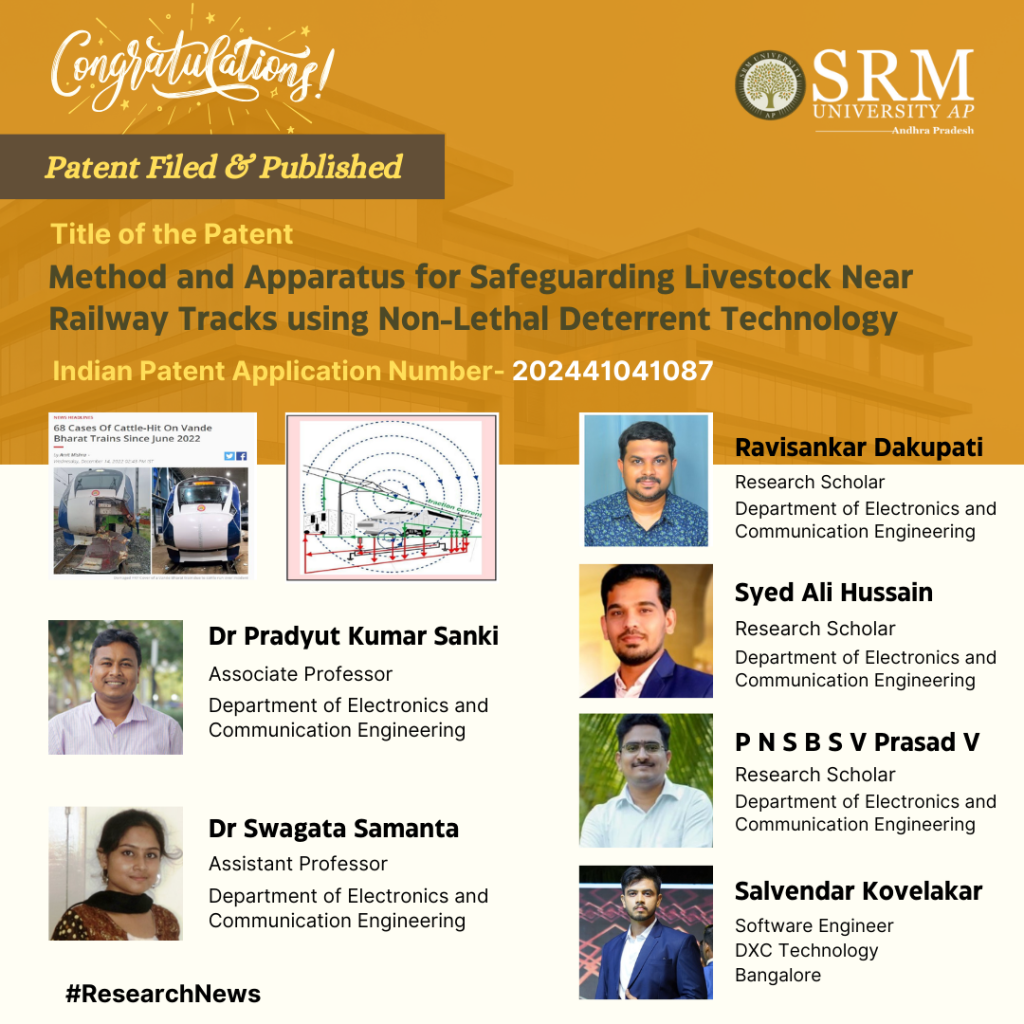
The Department of Electrical and Communication Engineering at SRM University-AP is delighted to announce the publication of a patent by its faculty, including Associate Professor Dr Pradyut Kumar Sanki and Assistant Professor Dr Swagata Samanta, along with research scholars Ravisankar Dakupati, Syed Ali Hussain, and P N S B S V Prasad V. The patent, titled “Method and Apparatus for Safeguarding Livestock Near Railway Tracks using Non-Lethal Deterrent Technology,” has introduced a groundbreaking solution that helps prevent accidents of wandering cattle. This innovative technology promises to protect livestock and minimise economic losses for cattle owners while championing the advancement of technology in countries like India.
Abstract:
Nowadays we have been hearing that Vandebharat express train hits cow, causing damage to both railways and cattle owners. We need to find a solution to this problem. These issues shouldn’t be hurdle for the growth of technology for developing countries like india. The technology we are going to use is a belt is worn by a cow. When the cow tries to cross near railway track it receives a Non-Lethal shock, makes the cow to scare and move back. All this circuit is operated with 7.4V DC
Practical implementation:
The practical implementation of the Anti-Track Cattle Band involves equipping cows with the device to prevent accidents near railway tracks. By detecting magnetic fields and delivering non-lethal shocks, the device ensures the safety of both the cattle and the railway infrastructure. This implementation can significantly reduce the risk of collisions and protect valuable livestock.
From a social perspective, the invention has several implications. It addresses the safety concerns of both animals and humans by preventing accidents and minimizing potential harm. By safeguarding livestock near railway tracks, the technology contributes to animal welfare and reduces economic losses for cattle owners. Additionally, the device promotes a more humane and proactive approach to mitigating risks associated with animal-human interactions in railway environments.Collaborations:
The research on the Anti-Track Cattle Band involved collaboration among a team of inventors with diverse expertise:
Ravisankar Dakupati – Research Scholar at SRM University-AP
Salvendar Kovelakar – Software Engineer at DXC Technology, Bangalore
Syed Ali Hussain – Research Scholar at SRM University-AP
P N S B S V Prasad V – Research Scholar at SRM University-AP
Dr Pradyut Kumar Sanki – Associate Professor at SRM University-AP
Dr Swagata Samanta – Assistant Professor at SRM University-AP
This collaborative effort brought together individuals with backgrounds in research, software engineering, and academia to develop and implement the innovative Anti-Track Cattle Band technology.Future Research Plans:
In future research for patent publication regarding “Apparatus and Method for Railway Livestock Protection,” the focus will likely be on enhancing sensor technology to detect animals more accurately over longer distances and in various conditions. This could involve integrating artificial intelligence and machine learning for improved detection and reducing false alarms. Additionally, there may be efforts to develop systems for remote monitoring and control, enabling real-time adjustments from a central location. Adaptability to different environments, collaboration for standardized protocols, cost-effectiveness, and assessing environmental impacts will also be key areas of interest. Overall, future research aims to create more effective, efficient, and sustainable solutions for protecting livestock around railway tracks
Continue reading → - A Breakthrough Patent for the Automated Abnormality Detection System July 22, 2024
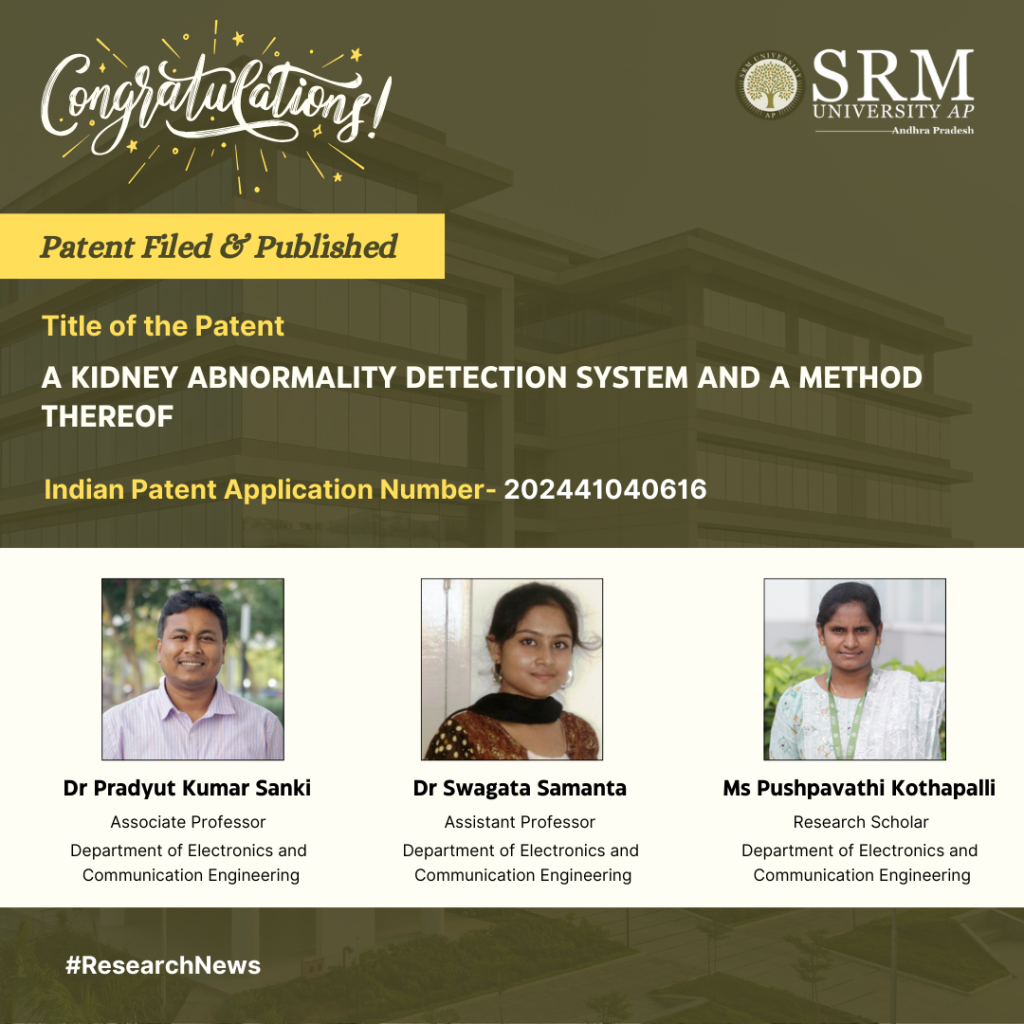
Dr Pradyut Kumar Sanki, Dr Swagata Samanta, and research scholar Ms Pushpavathi Kothapalli from the Department of Electronics and Communication Engineering published their patent titled “A Kidney Abnormality Detection System And a Method Thereof,” with Application No. 202441040616. This innovative method, which utilises advanced deep learning techniques, promises to revolutionise the accuracy and efficiency of kidney disease diagnosis. With the potential for widespread clinical adoption, this technology aims to enhance patient care, offering a brighter future for kidney disease detection and treatment.
Abstract:
This research work aimed to develop a method for detecting kidney diseases, including kidney stones, cysts, and tumors. The method achieved high accuracy in detecting kidney diseases, with a good mean average precision, precision, and recall. The study used techniques to select the most relevant features for kidney disease detection, identifying top features related to blood tests and patient health. The method outperformed other approaches in terms of accuracy, precision, and recall. The study used a comprehensive dataset of kidney disease patients to train and test the method. The results suggest that the method has the potential to be widely adopted in clinical settings, contributing to more accurate and efficient diagnostic tools for kidney disease detection and improving patient care.
Practical implementation:
The practical implementation of our research involves deploying a system for real-time detection and classification of kidney disease, including kidney stones, cysts, and tumors. The method achieved high accuracy in detecting kidney diseases using the Deep learning technique. Our model can quickly identify the disease of the kidney. The study used techniques to select the most relevant features for kidney disease detection, identifying top features related to blood tests and patient health. The method outperformed other approaches in terms of accuracy, precision, and recall. The study used a comprehensive dataset of kidney disease patients to train and test the method. The results suggest that the method has the potential to be widely adopted in clinical settings, contributing to more accurate and efficient diagnostic tools for kidney disease detection and improving patient care.
Future Research Plans:
The future plans for the work on chronic kidney disease (CKD) detection and management involve several key areas:1. Improved Screening and Diagnosis: Update the United States Preventive Services Task Force (USPSTF) recommendation for CKD screening to reflect current evidence supporting routine screening for high-risk asymptomatic adults.
2. Enhanced Patient Engagement and Person-Centered Care: Advance education of primary care clinicians about CKD risk factors, testing, detection, and interventions that are graded and proportional to the eGFR and uACR risk stratification or heat map.
3. Advancements in Nephrology: Develop novel therapeutic strategies, such as wearable artificial kidneys, xenotransplantation, stem cell-derived therapies, and bioengineered and bio-artificial kidneys, to improve renal replacement therapies and address the shortage of kidney donors.
4. Machine Learning and Predictive Modelling: Continue to evaluate and improve machine learning approaches for early CKD diagnoses, focusing on reducing the number of input features and enhancing the accuracy of prediction models.
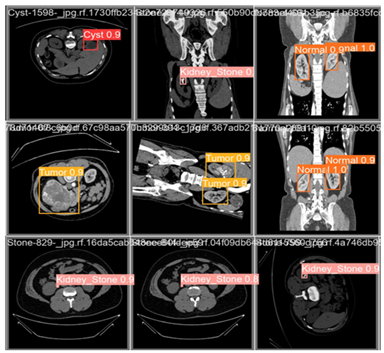
Continue reading → - Groundbreaking Paper Offers Geo-Temporal Visualisation of COVID-19 Spread in India July 18, 2024
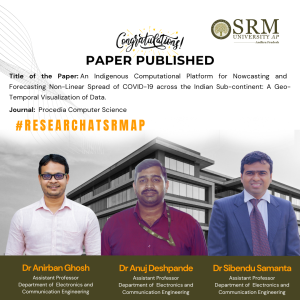 In an exciting development, Dr Anirban Ghosh, Dr Anuj Deshpande, and Dr Sibendu Samanta, Assistant Professors from the Department of Electronics and Communication Engineering, have recently achieved a significant milestone with the publication of their paper titled “An Indigenous Computational Platform for Nowcasting and Forecasting Non-Linear Spread of COVID-19 across the Indian Sub-continent: A Geo-Temporal Visualization of Data” in the esteemed journal, Procedia Computer Science.
In an exciting development, Dr Anirban Ghosh, Dr Anuj Deshpande, and Dr Sibendu Samanta, Assistant Professors from the Department of Electronics and Communication Engineering, have recently achieved a significant milestone with the publication of their paper titled “An Indigenous Computational Platform for Nowcasting and Forecasting Non-Linear Spread of COVID-19 across the Indian Sub-continent: A Geo-Temporal Visualization of Data” in the esteemed journal, Procedia Computer Science.The paper focuses on the development of a state-of-the-art computational platform specifically tailored for nowcasting and forecasting the non-linear spread of COVID-19 across the Indian sub-continent. This pioneering work promises to offer valuable insights into the geo-temporal visualisation of data related to the COVID-19 pandemic, with potential implications for public health interventions and policy decisions.
The publication of this paper serves as a testament to the innovative research being conducted by the faculty members at the Department of Electronics and Communication Engineering. Their dedication and expertise in the field have not only contributed to advancing scientific knowledge but also hold considerable promise for making a real-world impact in the ongoing fight against the COVID-19 pandemic. We extend our congratulations to Dr Anirban Ghosh, Dr Anuj Deshpande, and Dr Sibendu Samanta for this remarkable accomplishment and look forward to witnessing the continued impact of their research in addressing critical challenges facing the world today.
Abstract
The rapid spread of the COVID-19 pandemic necessitated unprecedented collective action against coronavirus disease. In this light,we are proposing a novel online platform for the visualisation of epidemiological data incorporating social determinants for understanding the patterns associated with the spread of COVID- 19. The current AI computational platform combines modelling methodologies along with temporal, geospatial visualisation of COVID-19 data, providing real-time sharing of graphic analytical simulation of vulnerable hotspots of recurrent (nowcasting) and emergent (forecasting) infections visualised on a spatiotemporal scale on geoportals. The proposed study will be a secondary data analysis of primary data accessed from the national portal (Indian Council of Medical Research (ICMR)) incorporating 766 districts in India. Epidemiological data related to spatiotemporal visualisation of the demographic spread of COVID-19 will be displayed using a compartmental socio-epidemiological model, reproduction number R, epi-curve diagrams, as well as choropleth maps for different levels of administrative and development units at the district levels.
Explanation of the Research in Layperson’s Terms
The rapid spread of COVID-19 required quick and coordinated action. To aid the process, we have created a new online platform to help visualise COVID-19 data, including social factors that affect its spread. Our platform uses advanced computer models and shows COVID-19 data over time and across locations. It allows real-time sharing of visual analyses, highlighting areas at risk for current and future infections. The effectiveness of the platform lies in the fact that it is not limited to COVID-19. It can be suitably modified and employed for capturing similar trends for any future pandemic.
Title of the Research in the Citation Format
Priya Ranjan, Dhruva Nandi, Karuna Nidhi Kaur, Rohan Rajiv, Kumar Dron Shrivastav, Anirban Ghosh, Anuj Deshpande, Sibendu Samanta, Rajiv Janardhanan, “An Indigenous Computational Platform for Nowcasting and Forecasting Non-Linear Spread of COVID-19 across the Indian Sub-continent: A Geo-Temporal Visualization of Data”, Procedia Computer Science, Volume 235, 2024, Pages 496-505, ISSN 1877-0509,
https://doi.org/10.1016/j.procs.2024.04.049Practical Implementation and Social Implications Associated
As mentioned earlier, the platform can be used to present real-time data analysis and identify emerging and current hotspots of the COVID-19 pandemic. However, the beauty or robustness of the platform lies in the fact that it can be suitably adapted for similar analysis for any future pandemic with minimum effort.
Collaborations
- University of Petroleum and Energy Studies, Energy Acres, Dehradun, Uttarakhand, India
- SRM Medical College Hospital and Research Centre, SRMIST, Kattankulathur, Tamil Nadu, 603203, India
- Amity Institute of Public Health, Amity University, Noida, Uttar Pradesh, 201303, India
Future Research Plans
The future plan includes improving the visual and graphical presentation of the platform to provide more insightful and intuitive information. Aggregation of data from other international databases would further augment the effectiveness of the platform by not limiting it to only the national scenario.
Continue reading → - Innovative Aquaculture Monitoring System Patented by Dr K A Sunitha and Team June 27, 2024
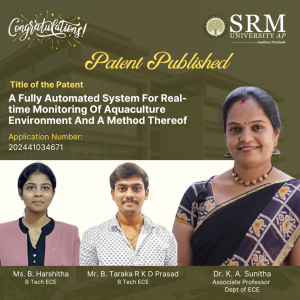 In a significant advancement for aquaculture technology, Dr K A Sunitha, Associate Professor in the Department of Electronics and Communication Engineering, along with her B.Tech ECE students Ms B Harshitha and Mr B Taraka Rameswara Kanaka Durga Prasad, have made headlines with their latest invention. The team has successfully filed and published a patent for “A Fully Automated System for Real-Time Monitoring of Aquaculture Environment and a Method Thereof.” The application number 202441034671, has been officially recorded in the Patent Office Journal, marking a milestone for the team and the institution they represent.
In a significant advancement for aquaculture technology, Dr K A Sunitha, Associate Professor in the Department of Electronics and Communication Engineering, along with her B.Tech ECE students Ms B Harshitha and Mr B Taraka Rameswara Kanaka Durga Prasad, have made headlines with their latest invention. The team has successfully filed and published a patent for “A Fully Automated System for Real-Time Monitoring of Aquaculture Environment and a Method Thereof.” The application number 202441034671, has been officially recorded in the Patent Office Journal, marking a milestone for the team and the institution they represent.
This pioneering system promises to revolutionise the way aquaculture environments are monitored by leveraging automation to ensure real-time, accurate assessments. The invention stands as a testament to the innovative spirit and dedication of Dr Sunitha and her students, who are now recognised as contributors to the technological advancements in the field of aquaculture.Abstract
This project involves the design and development of an Automated water quality analysis system to assist aquaculture farmers. The proposed system is tailored for aquatic environments, particularly ponds to monitor crucial parameters say Dissolved Oxygen (DO), PH, Temperature and Humidity levels, signaling when concentrations drop below the predefined threshold set by the user every thirty minutes. The system features autonomous activation and deactivation of aerators to ensure continual oxygenation of water and aids in energy optimisation. Utilising advanced sensors and a microcontroller, the device offers continuous monitoring of parameters to facilitate pond operators with timely insights into water quality dynamics, enabling proactive interventions to protect aquatic ecosystems.
Brief Explanation of the Project
India is the second-largest aquaculture nation in the world, and this sector provides livelihood support to about 280 lakh people. The aquaculture industry globally faces numerous challenges, such as Viral, bacterial, and fungal diseases and Suboptimal water quality. One crucial criterion for evaluating the quality of water is measuring the Dissolved Oxygen level. Water and other liquids contain free, non-compound oxygen, which is measured as dissolved oxygen (DO).
Long-term exposure to low DO levels increases stress and infections and, in certain situations, causes the death of the organism because dissolved oxygen is essential for the health and reproduction of many fish and invertebrates. This project highlights the design of a timer based automated water quality analysis system which can be used in the inland aquaculture farms to continuously monitor the water parameters and automate the calibration process and the operation of aerators without human intervention.
Practical Implications of the Research
The main objectives of this research are
1) To monitor the parameters, say Dissolved Oxygen, PH, Temperature and Humidity levels
every thirty minutes.
2) To automate the Calibration process to maintain accuracy and reliability of the system.
3) To automatically turn ON/OFF the aerators in the event of Low/High oxygen levels detection in the pond.
4) To send notifications to the technician or farmer every thirty minutes to help them monitor.Future Research Plans
The developed prototype is currently validated with standard DO meter during experimental trials. Moving forward, further research and development efforts may focus on refining the system’s functionality, expanding its sensor capabilities, and integrating advanced analytics for predictive monitoring and decision support, thereby advancing the state-of-the-art in aquaculture management technology and promoting the long-term viability of inland aquaculture operations.
Pictures Related to Research
Continue reading →